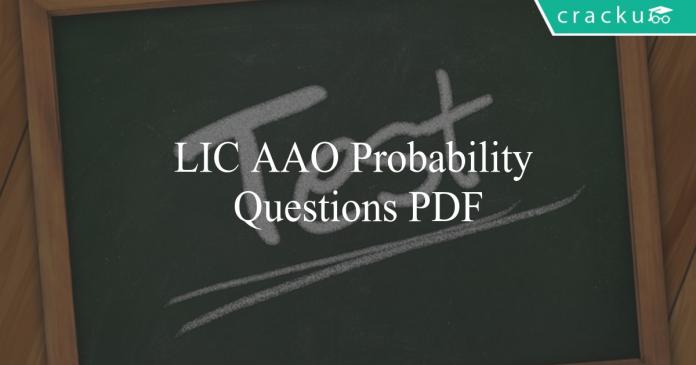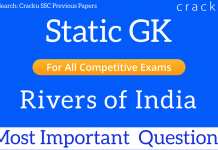LIC AAO Probability Questions PDF
Download Important Probability questions for LIC AAO exam. Top 20 Probability questions with answers based on previous year asked questions.
Download lic aao probability questions pdf
Take a free mock test for LIC AAO
Download LIC AAO Previous Papers PDF
Question 1: The circle given at right side is divided into eight sectors of equal area. What is the probability that the spinner will land on an even-numbered region in each of two consective spins ?

a) $\frac{25}{10}$
b) $\frac{3}{8}$
c) $\frac{1}{4}$
d) $\frac{9}{64}$
Question 2: A class of 30 students occupy a classroom containing 5 rows of seats, with 8 seats in each row. If the students seat themselves at random, the probability that the sixth seat in the fifth row will be empty is
a) $\frac{1}{5}$
b) $\frac{1}{3}$
c) $\frac{1}{4}$
d) $\frac{2}{5}$
Question 3: A bag contains 2 red marbles, 3 green marbles and 4 blue marbles. A marble is picked at random from the bag. What is the probability that the marble is not a blue marble ?
a) $\frac{4}{9}$
b) $\frac{5}{9}$
c) $\frac{1}{9}$
d) $\frac{2}{9}$
Download LIC AAO Previous Papers PDF
100 Free Computer Awareness Tests for LIC
Question 4: Ravi rolled a dice twice. What is the probability that sum of both the outcome is less than 5?
a) 1/6
b) 1/4
c) 1/3
d) 1/2
e) None of the above.
Question 5: Raghu tosses a coin 6 times. The probability that the number of times he gets heads will not be greater than the number of times he gets tails is
a) 21/64
b) 3/32
c) 41/64
d) 21/32
e) 1/2
Question 6: A fair dice is rolled twice. Find the probability that he gets at least one composite number.
a) $\frac{5}{36}$
b) $\frac{3}{4}$
c) $\frac{5}{9}$
d) $\frac{4}{9}$
e) $\frac{5}{12}$
Question 7: Raghu has gotten calls for interviews from top 4 management institutes of a country. The probability that he converts an interview of an institute is 50%. What is the probability of Raghu converting the interview of at least 1 management institute?
a) 93.75%
b) 92.25%
c) 95.75%
d) 96.25%
e) 94.75%
100 Free GK Tests for Insurance Exams
Question 8: A circular disc of diameter 3.5 cm is thrown inside a circle of radius 7 cm. What is the probability that the disc will remain completely within the circle?
a) 10%
b) 25%
c) 20%
d) 50%
e) 35%
Question 9: In a box carrying one dozen of oranges one third have become bad.If 3 oranges taken out from the box random ,what is the probability that at least one orange out of the 3 oranges picked up is good ?
a) 1/55
b) 54/55
c) 45/55
d) 3/55
e) None of these
Instructions
Study the information carefully to answer the following questions:
A bucket contains 8 red, 3 blue and 5 green marbles.
Question 10: If 3 marbles are drawn at random, what is the probability that none is red ?
a) ${3 \over 8}$
b) ${1 \over {16}}$
c) ${1 \over {10}}$
d) ${3 \over {16}}$
e) None of these
LIC AAO REASONING QUESTIONS PDF
Answers & Solutions:
1) Answer (B)
2) Answer (C)
3) Answer (B)
Without blue marbles, there are 2 red marbles and 3 green marbles.
Therefore, there are 5 marbles in all to choose the required 1 from.
Probability that the marble is ot a blue marble = 5C1/ 9C1
= $\frac{5}{9}$
Therefore, the correct option is option B.
4) Answer (A)
When a dice is rolled we get outcome from (1,2,3,4,5,6) so favourable cases (Sum = 2,3,4)
Favourable cases = (1,1) (1,2) (2,1) (1,3) (3,1) (2,2)
Total cases = 6*6 = 36
So probability $= \frac{ \text{Favourable cases}}{\text{Total cases}}$
$= \frac{6}{36} =\frac{1}{6}$
5) Answer (D)
Probability of getting a head = 0.5
Probability of getting a tail = 0.5
Number of heads $\leq$ Number of tails.
Therefore, the number of heads can be 0,1, 2 or 3.
Sample space = $2^6$ = 64.
0 heads can be obtained in 6C0 = 1 way.
1 head can be obtained in 6C1 = 6 ways.
2 heads can be obtained in 6C2 = 30/2 = 15 ways.
3 heads can be obtained in 6C3 = 20 ways.
Required probability = (20+15+6+1)/64 = 42/64 = 21/32.
Therefore, option D is the right answer.
6) Answer (C)
The probability that he gets at least one composite number = 1 – p(no composite number)
The numbers which are not composite = 1, 2, 3, 5
Hence, the probability that he gets them both the times = $\frac{4}{6} * \frac{4}{6} = \frac{4}{9}$
Required probability = $1 – \frac{4}{9}$ = $\frac{5}{9}$
7) Answer (A)
Raghu can get selected in 1 college, 2 colleges, 3 colleges or all 4 colleges. Let us subtract the probability of Raghu not getting selected in any of the colleges from the total probability to get the required probability.
Probability of converting the interview of a college = 0.5
Therefore, probability of not converting the interview of a college = 1-0.5 = 0.5
Probability of not converting any of the 4 colleges = 0.5*0.5*0.5*0.5 = 0.0625 or 6.25%
Therefore, probability of converting at least 1 college = 100 – 6.25 = 93.75%.
Therefore, option A is the right answer.
8) Answer (B)
For the disc to remain completely remain within the circle, the centre of the disc must at-least be 3.5cm away from the circumference of the circle.
Radius of the outer circle = $7$ cm
Radius of the inner circle = $7 – 3.5$ = $3.5$ cm.
The centre of the circle must fall within the inner circle. Of the total area of the outer circle, only the inner circle is the area that the centre of the coin can fall within without violating the conditions.
Probability = Ratio of the areas of the $2$ circles.
The radius of the outer circle is twice the radius of the inner circle.
Ratio of areas = $\frac{\pi r^2}{\pi (2r)^2}$
Therefore, the areas will be in the ratio $1:4$.
Therefore, the required probability is $25$%. Hence, option B is the right answer.
9) Answer (B)
Total number of oranges in the box = 12
Number of ways of selecting 3 oranges out of 12 oranges, n(S) = $C^{12}_3$
= $\frac{12 \times 11 \times 10}{1 \times 2 \times 3} = 220$
Number of oranges which became bad = $\frac{12}{3}=4$
Number of ways of selecting 3 oranges out of 4 bad oranges = $C^4_3 = C^4_1 = 4$
Number of desired selection of oranges, n(E) = 220 – 4 = 216
$\therefore$ $P(E) = \frac{n(E)}{n(S)}$
= $\frac{216}{220}= \frac{54}{55}$
=> Ans – (B)
10) Answer (C)
Number of ways of drawing 3 marbles out of 16
$n(S) = C^{16}_3 = \frac{16 \times 15 \times 14}{1 \times 2 \times 3}$
= $560$
Out of the three drawn marbles, none is red, i.e., they will be either blue or green.
=> $n(E) = C^8_3 = \frac{8 \times 7 \times 6}{1 \times 2 \times 3}$
= $56$
$\therefore$ Required probability = $\frac{n(E)}{n(S)}$
= $\frac{56}{560} = \frac{1}{10}$





